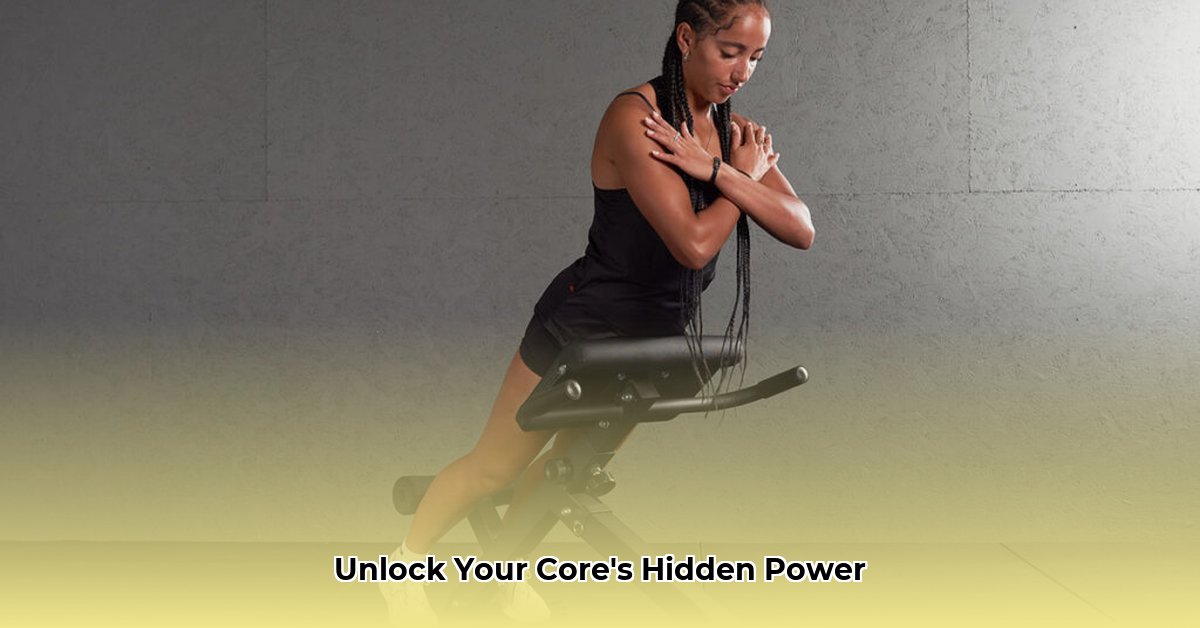Got lower back pain? Want a stronger core and better posture? This guide shows you how to strengthen your erector spinae muscles – the muscles that run along your spine. We’ll walk you through the best exercises, step-by-step, so you can do them safely and effectively, whether you’re a seasoned athlete or just starting out. We’ll cover everything from proper form to how to gradually make the exercises harder, plus tips to avoid injury. Let’s get your back feeling its best!
Erector Spinae Exercises: Strengthen Your Core and Back
Want a stronger core and a healthier back? Then you need to get acquainted with your erector spinae muscles – they’re the unsung heroes of your posture and back strength. Think of them as your spine’s internal support system, a powerful corset that keeps you upright and helps you move with ease. Neglecting these muscles can lead to weakness, stiffness, and even back pain. Strengthening your erector spinae not only improves physical performance but also enhances everyday movements and reduces the likelihood of back-related ailments. Let’s dive into some exercises to help you strengthen these important muscles. Let’s explore the realm of spinal erectors exercises!
Understanding Your Back’s Powerhouse: The Erector Spinae
Your erector spinae muscles are a group of muscles that run along your spine, from your lower back all the way up to your neck. They’re not just one muscle, but a collection of different muscles working together. The erector spinae group is composed of three primary muscles: the iliocostalis, longissimus, and spinalis. These muscles are crucial for bending backward (extension), twisting (rotation), and bending sideways (lateral flexion). Strong erector spinae muscles are essential for good posture, lifting heavy things safely, and preventing backaches. In short, they’re a vital part of a strong, healthy back. Now, delve into erector spinae muscle anatomy!
Building a Strong Foundation: Compound Exercises
Compound exercises are your best friends when it comes to building overall strength, and they’re great for working your erector spinae along with other major muscle groups. These exercises engage multiple joints and muscle groups simultaneously, which maximizes muscle activation and promotes functional strength. Think of these as the foundation upon which you’ll build further strength and power. Remember, perfect form beats brute force every time – start light and focus on technique to avoid injuries.
-
Deadlifts – The King of Back Exercises: The deadlift is a classic for a reason. Properly performed, it’s incredibly effective for working your entire posterior chain, including your erector spinae, glutes, hamstrings, and core. It might seem intimidating at first, but it’s a worthwhile investment of time and effort.
- Step 1: Setup: Stand with your feet hip-width apart, positioned so the barbell is directly over the middle of your feet. Keep your back straight—imagine a string pulling you upright from the crown of your head. Your shoulders should be slightly in front of the bar.
- Step 2: The Hinge: Hinge at your hips, bending from your hips, not your waist, as you grasp the bar with an overhand grip, slightly wider than shoulder-width apart. Use a mixed grip (one hand over, one hand under) for heavier weights. Your back should remain straight throughout this movement.
- Step 3: The Lift: Keeping your core engaged (think about bracing your belly), drive through your heels to lift the bar. Don’t jerk or rush; it’s a smooth, controlled movement. As you lift, keep the bar close to your body. Your back should remain straight as you lift.
- Step 4: The Lower: Slowly lower the bar back down, reversing the movement, maintaining that same straight back. Control the descent to engage your muscles throughout the entire range of motion.
-
Romanian Deadlifts (RDLs): Similar to conventional deadlifts but with a slightly different focus. RDLs emphasize your hamstrings and glutes but still heavily engage your erector spinae for stability. You’ll feel a great stretch in the back of your legs.
- Step 1: Setup: Start with a barbell or dumbbells held in front of your thighs. Maintain a slight bend in your knees.
- Step 2: The Hinge: Hinge at your hips, keeping your back straight, and lowering the weight until you feel a good stretch in your hamstrings. Your knees should remain slightly bent throughout the movement. Focus on pushing your hips back as you lower the weight.
- Step 3: Return to Start: Squeeze your hamstrings and glutes as you return to a standing position. Maintain a straight back and controlled movement.
-
Rack Pulls – A Deadlift Variation: Rack pulls are like deadlifts but you start with the barbell already elevated – a great option to focus on the pulling phase and reduce stress on your lower back, especially useful for beginners or those recovering from injury. Experiment with differing bar heights to find what works best for you. Setting the bar at or just above knee level is a common starting point.
Focusing In: Isolation Exercises for Targeted Strength
Isolation exercises target your erector spinae more directly – they help you strengthen those muscles specifically and address any weak points identified while doing compound exercises. While compound exercises contribute to overall back and core strength, isolation exercises are beneficial for enhancing specific muscle definition and reinforcing stability. These movements can significantly enhance your functional strength.
-
Back Extensions: This exercise is fantastic for directly targeting your lower back muscles. You’ll feel it working!
- Step 1: Setup: Lie face down on a back extension machine, securing your ankles under the pads. Adjust the pad so it sits just below your hip bones, allowing you to bend freely at the waist.
- Step 2: The Extension: Slowly extend your torso upwards, feeling the contraction in your erector spinae. Don’t arch your back excessively. Maintain a neutral spine throughout the movement.
- Step 3: Controlled Return: Slowly lower your torso back down to the starting position, maintaining control throughout the movement. Avoid bouncing or using momentum.
-
Hyperextensions (Bodyweight): A bodyweight variation of the back extension; ideal for building strength progressively. Concentrate on slow, controlled movements. Make sure your form is perfect before adding weight.
- Step 1: Position: Lie face down on a hyperextension bench, with your ankles secured under the pads. Adjust the height of the bench so that your hips are supported and you can move freely.
- Step 2: Extension: Slowly raise your upper body, engaging your erector spinae. Keep your movements smooth and controlled.
- Step 3: Control: Lower yourself slowly back down, maintaining control. Focus on engaging the erector spinae muscles throughout the entire movement.
-
Good Mornings (Advanced): These are similar to RDLs, but they emphasize spinal extension more, heavily activating your erector spinae. This exercise is best suited for those who have built a solid foundation of strength. Due to the potential for lower back strain, you might want to avoid these until you’re comfortable with deadlifts and RDLs.
No Gym? No Problem! Bodyweight Erector Spinae Exercises
You don’t need a gym or fancy equipment to build strong erector spinae muscles. Bodyweight exercises are accessible and perfect for beginners or for adding variety to your workouts. These exercises can be performed anywhere and require no specialized equipment, making them ideal for home workouts or travel. They also improve core control as you focus on proper form.
-
Bird Dog – Balance and Core Control: This excellent exercise improves core stability and engages your erector spinae. Focus on maintaining your balance. The Bird Dog not only strengthens the back but also improves coordination and balance, making it an excellent addition to any fitness routine.
- Step 1: Position: Begin on your hands and knees, maintaining a neutral spine. Your hands should be directly under your shoulders, and your knees should be directly under your hips.
- Step 2: Extension: Extend one arm forward and the opposite leg backward simultaneously, keeping your back straight. Avoid twisting or arching your back.
- Step 3: Hold and Return: Hold for a second or two, then return to your starting position. Repeat on the other side. Focus on controlled movement.
-
Superman – For Your Entire Posterior Chain: This targets your entire back, including your erector spinae, glutes, and hamstrings.
- Step 1: Position: Lie face down, with your arms and legs extended. Keep your neck in a neutral position, looking down at the floor.
- Step 2: Lift: Simultaneously lift your arms and legs off the ground, contracting your back muscles. Focus on squeezing your glutes and erector spinae.
- Step 3: Lower: Slowly lower your limbs back to the ground. Maintain control throughout the movement.
Progressing Safely and Smartly: The Key to Success
The key to building strength lies in progressive overload – gradually increasing the weight, reps (repetitions), or sets (groups of repetitions) over time to continually challenge your muscles. It’s important to listen to your body. Rest when needed, and never push through sharp pain. If you have any pre-existing
- Plastic Bento Boxes Face Scrutiny Over Sustainability Impacts - December 11, 2025
- Bento Tray Revolutionizes Organized Meal Transport and Presentation - December 10, 2025
- Meal Plans for Busy Schedules That Make Healthy Eating Easy - December 10, 2025










